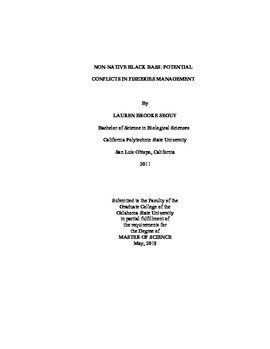| dc.contributor.advisor | Long, James M. | |
| dc.contributor.author | Seguy, Lauren Brooke | |
| dc.date.accessioned | 2019-10-25T20:25:22Z | |
| dc.date.available | 2019-10-25T20:25:22Z | |
| dc.date.issued | 2019-05-01 | |
| dc.identifier.uri | https://hdl.handle.net/11244/321610 | |
| dc.description.abstract | Black bass (Micropterus spp.) are among the most highly sought after recreational fishes around the world, which has resulted in widespread introductions outside of their indigenous ranges. Non-native black bass can, simultaneously, imperil native biodiversity and bring economic benefits to local economies, thus highlighting the paradox of stocking sport fishes. In an effort to disentangle these fundamentally incompatible forces, I systematically reviewed the ecological and economic impacts of non-native black bass, which has not been updated in over 30 years. Considering the constant flux of human-mediated dispersal events, the distribution of the two most stocked species of non-native black bass, Largemouth (M. salmoides) and Smallmouth Bass (M. dolomieu), were reevaluated. Further, I administered a novel broad scale survey of U.S. fisheries biologists assessing current perceptions surrounding the ecological and economic impacts of non-native black bass. My updated distribution represents data from the most recently available sources and has filled a knowledge gap concerning the current range of these species. The establishment success rate between Largemouth Bass (76%) and Smallmouth Bass (22%) differed widely, suggesting that ecological and biological factors influence their distribution. The case studies highlighted within show a global reevaluation of socio-economic values and conservation priorities in relation to the level of risk associated with non-native species. My survey results indicate that non-native black bass are considered economically beneficial in both anthropogenic and natural waters. Contrastingly, non-native black bass were perceived to have significantly more negative ecological impacts in natural waters than in anthropogenic waters. Largemouth Bass, Smallmouth Bass, and Florida Bass (M. floridanus) were perceived to provide the most economic benefits, while Alabama Bass (M. henshalli), Smallmouth Bass, and Spotted Bass (M. punctulatus) were perceived to cause the most ecological imperilment. My findings suggest that habitat may be an important factor to partitioning the conflicting ecological-economic dynamic of non-native black bass. Implications of this study suggest that challenges remain for managers attempting to balance the paradoxical nature of non-native black bass as both a desired sport fish and as a potentially harmful invader. | |
| dc.format | application/pdf | |
| dc.language | en_US | |
| dc.rights | Copyright is held by the author who has granted the Oklahoma State University Library the non-exclusive right to share this material in its institutional repository. Contact Digital Library Services at lib-dls@okstate.edu or 405-744-9161 for the permission policy on the use, reproduction or distribution of this material. | |
| dc.title | Non-Native Black Bass: Potential Conflicts in Fisheries Management | |
| dc.contributor.committeeMember | Hickman, Karen R. | |
| dc.contributor.committeeMember | Wilson, Gail W. T. | |
| osu.filename | Seguy_okstate_0664M_16169.pdf | |
| osu.accesstype | Open Access | |
| dc.type.genre | Thesis | |
| dc.type.material | Text | |
| dc.subject.keywords | black bass | |
| dc.subject.keywords | ecological threats | |
| dc.subject.keywords | economic benefits | |
| dc.subject.keywords | human dimensions | |
| dc.subject.keywords | invasive species | |
| dc.subject.keywords | micropterus | |
| thesis.degree.discipline | Natural Resource Ecology and Management | |
| thesis.degree.grantor | Oklahoma State University | |
